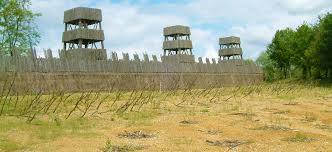The Epic Battle of Alesia : Julius Caesar vs Vercingetorix

“I don't know where Alesia is! Nobody knows where Alesia is! Shouts Vitalstatistix in The Arvernian Shield. And, a few pages later, the authors note: "This attitude, which has been perpetuated through the centuries, means that the location of the Gallic defeat remains, even nowadays, quite mysterious ... Regrettable chauvinism!"
In fact of chauvinism, historians sometimes engage in quarrels over chapels or steeples as bitter as the battles of the armies they are studying. Such was the case in the fierce controversy which arose in France in the 19th century to determine the site of a very famous battle, almost 2,000 years old.
The shock of Julius Caesar and Vercingetorix
The Siege of Alesia is remembered; object of capital stakes, it opposes, in 52 BC, two illustrious warlords: Julius Caesar, the Roman, and Vercingetorix, the Gaul.
This battle puts an end to the last revolt of Gaul against the Romans. The Gallic leader, Vercingetorix, took refuge with his troops in a fortified position of the Mandubian tribe, the oppidum of Alesia, witness to the degree of civilization reached by the Celts from the interior of Gaul in the 1st century BC. An oppidum is an embryo of a city which essentially fulfills a defensive function. The Gallic tribe must be able to take refuge there and protect themselves from an enemy, hence the choice of high positions, more easily defended against the invader.

This is the case of Alesia, at least as described by Caesar in the Gallic Wars: a plateau of about 90 hectares, cut off from the plain by a fairly steep cliff, where the only accesses are barred by a dry stone wall built around a frame of intersecting beams and nails, able to withstand both fire and ram, the formidable weapon used to break down the walls or doors of besieged places. In short, an impregnable place ...
And yet, Caesar and his legionaries, at the cost of gigantic works of fortifications, will achieve a methodical encirclement that nothing and no one will be able to break. After legions of an indigenous relief army are crushed, the besieged surrendered. The Gallic War is over. The archaeologist’s war has yet to begin.
Battle of Alesia location : a debate that ignites the scientists of the Second Empire
In Burgundy, an immemorial tradition places Alesia on a small relief on the edge of the Langres Plateau (Côte-d´Or), Mount Auxois, belonging to the town of Alise-Sainte-Reine. And no one dreams of contesting this tradition: doesn't the very name of Alise seem directly derived from Alesia?
Everything changed in 1855. The scandal came through a learned society, the Société d'Émulation du Doubs, which seemed to want to set itself up as the standard bearer of the interests of Franche-Comté and its historic primacy over Burgundy. At the instigation of an architect from Besançon, a man named Delacroix, it proposed to locate Alesia in Alaise, in the Doubs, and immediately garnered the support of several renowned scientists. Their Burgundian counterparts protested strongly in favor of Alise.
The quarrel quickly becomes national; memoirs, brochures and even taken to task by scholars through the press are multiplying. The most important cultural institutions, such as the Académie des Inscriptions et Belles-Lettres, refuse to play a role of arbiter. The affair took on such importance that the Emperor Napoleon III, author of History of Julius Caesar, took an interest in it: to restore calm, he created a Commission on the topography of Gaul, responsible for coordinating a program of excavations and to draw up an exact map of French territory at the beginning of our era.
From false discoveries to real archaeological finds
From the first works around Alise in 1860, axes and bronze weapons were unearthed: the Burgundians immediately claimed victory! Wrongly, because in 52 BC, it has been over a millennium since the Bronze Age, and Gallic civilization is advanced enough to have iron weapons ...
There are also ditches that could correspond to the fortification works of Caesar and his legions, who gives precise measurements in his Commentaries on the Gallic War; easily dated Roman coins are also found: all are older than 52 BC.
Is this sufficient proof? Opinions are divided. We will even go so far as to measure, in all possible directions, the valley dominated by Mount Auxois to check if it corresponds with the dimensions estimated by Caesar: 3,000 steps ... But everything depends, in fact, in which direction it is measured!
The excavators of the Second Empire will still find a mass grave with bones, carcasses of horses and weapons at the foot of the hill where, it is supposed, the relief army was broken on the Roman defenses...
When scientific truth meets local tradition
In 1906, exploration was resumed on Mount Auxois by scholars from the Société des Sciences Historique de Semur-en-Auxois. The discoveries are, this time, numerous and decisive to the point that excavations, even today, have been divided into chronological areas.
The Gallic Alesia and its defense system continue to interest researchers, but the Gallo-Roman city and even that of the first centuries of our era also reveal great wealth: forum, public monuments, houses, first Christian basilicas, etc.
At present, although the voices claiming the primacy of Alaise's site have never been completely silent, there is virtually no longer any doubt. The debates of local scholars no longer go beyond steeplechase quarrels, and scientific archeology has come to prove that Alesia, as tradition has claimed, was indeed located on Mount Auxois.









































































































































































































































































































































